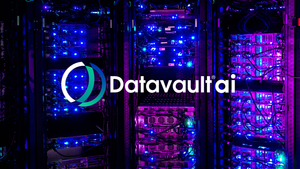
Data storage manufacturer Seagate (NASDAQ: STX) beat Wall Street’s revenue expectations in Q1 CY2025, with sales up 30.5% year on year to $2.16 billion. On the other hand, next quarter’s revenue guidance of $2.4 billion was less impressive, coming in 0.6% below analysts’ estimates. Its non-GAAP profit of $1.90 per share was 9.3% above analysts’ consensus estimates.
Is now the time to buy STX? Find out in our full research report (it’s free).
Seagate Technology (STX) Q1 CY2025 Highlights:
- Revenue: $2.16 billion vs analyst estimates of $2.14 billion (30.5% year-on-year growth, 0.9% beat)
- Adjusted EPS: $1.90 vs analyst estimates of $1.74 (9.3% beat)
- Adjusted EBITDA: $570 million vs analyst estimates of $559.6 million (26.4% margin, 1.9% beat)
- Revenue Guidance for Q2 CY2025 is $2.4 billion at the midpoint, below analyst estimates of $2.42 billion
- Adjusted EPS guidance for Q2 CY2025 is $2.40 at the midpoint, above analyst estimates of $2.05
- Operating Margin: 20%, up from 8.6% in the same quarter last year
- Free Cash Flow Margin: 10%, up from 7.7% in the same quarter last year
- Inventory Days Outstanding: 96, up from 89 in the previous quarter
- Market Capitalization: $21.64 billion
StockStory’s Take
Seagate’s first quarter results were shaped by strong demand for high-capacity storage drives, particularly from global cloud customers, and the company’s ongoing focus on profitability and operational leverage. CEO Dave Mosley attributed the year-on-year revenue growth to Seagate’s build-to-order supply model and disciplined supply management, which allowed the company to prioritize high-value product segments and navigate recent supply constraints. Mosley emphasized, “Our supply discipline, the visibility we gain through our build-to-order strategy, and our execution on strategic pricing actions all contribute to sustainable and profitable growth over the long-term.”
Looking ahead, management’s guidance reflects both opportunities and caution. The company anticipates continued cloud-driven demand and further adoption of its HAMR (Heat-Assisted Magnetic Recording) technology, but also flagged potential risks from new trade tariffs and evolving customer procurement behaviors. CFO Gianluca Romano stated that Seagate expects “minimal direct impact from tariff policies” in the coming quarter, but noted that the company is monitoring for secondary effects on customer demand. The team reiterated a commitment to improving margins and free cash flow, while remaining agile in response to macroeconomic and policy changes.
Key Insights from Management’s Remarks
Seagate’s management highlighted a combination of operational improvements, product transitions, and resilient cloud demand as primary factors behind its quarterly performance. The company also discussed ongoing technology shifts and supply-demand dynamics shaping its near-term outlook.
- Cloud nearline demand surge: Seagate saw significant growth in nearline hard drive shipments to global cloud providers, driven by increased data center investments and AI-related workloads. Management noted that nearline exabyte shipments nearly doubled year-over-year and that this segment now represents the majority of mass capacity volume.
- HAMR technology ramp: The company’s rollout of HAMR-based Mozaic drives is progressing, with multiple cloud customers in qualification stages. Management indicated that HAMR contributed incrementally to quarterly results, with expectations for broader adoption and higher shipment volumes in the second half of the year.
- Build-to-order model effectiveness: Seagate’s adoption of a build-to-order supply chain model improved supply predictability and allowed the company to manage customer allocations during recent supply constraints. This approach has enhanced the company’s agility amid industry volatility.
- Pricing and product mix discipline: Strategic pricing actions and a richer sales mix of high-capacity drives supported the expansion of gross and operating margins. Management highlighted that these factors, along with initial HAMR sales, helped offset declines in legacy product segments.
- Tariff and supply chain risk management: While management expects minimal direct impact from recently announced tariffs in the next quarter, it is evaluating longer-term strategies such as geographic diversification of manufacturing and supply chains to mitigate potential trade disruptions.
Drivers of Future Performance
Management’s outlook centers on demand from large cloud and hyperscale customers, ongoing technology transitions, and the company’s ability to adapt to trade policy changes and supply chain risks.
- Cloud and AI infrastructure demand: Seagate expects continued strength in cloud nearline storage as data center operators expand capacity to support AI and video workloads. The company believes that both hyperscale and smaller edge data centers will drive exabyte demand well into next year.
- HAMR adoption and product transitions: The successful qualification and ramp of HAMR-based drives are expected to accelerate revenue growth and support margin expansion, as these products offer higher capacities and improved cost efficiency compared to traditional PMR (Perpendicular Magnetic Recording) drives.
- Tariff and supply chain adaptation: While management anticipates only minor direct impacts from new tariffs in the near term, there is ongoing monitoring for indirect effects on customer procurement. The company is prepared to adjust its manufacturing footprint and renegotiate supply agreements if trade disruptions intensify.
Top Analyst Questions
- Erik Woodring (Morgan Stanley): Asked how Seagate achieved upside despite supply constraints and whether guidance would have changed if announced earlier. Management cited the predictability of its build-to-order model and stated guidance would have remained the same.
- Asiya Merchant (Citi): Requested details on HAMR drive qualification and contribution to results. Management revealed that HAMR drives contributed incremental volume and that qualifications remain on track for broader adoption in the second half of the year.
- C.J. Muse (Cantor Fitzgerald): Questioned improvements in demand visibility and pricing dynamics. Management emphasized improved visibility into customer demand into next year and highlighted ongoing pricing discipline in new contracts.
- Wamsi Mohan (Bank of America): Sought clarification on margin expansion given product mix changes. CFO Gianluca Romano explained that higher cloud nearline volumes and timing of price increases influence margin trends, with the overall strategy focused on consistent improvement.
- Hadi Orabi (TD Cowen): Asked about the timeline and approach for passing through tariff-related costs if needed. Management explained that cost pass-through would be a last resort, with operational adjustments and customer negotiations preferred to maintain margins.
Catalysts in Upcoming Quarters
In the coming quarters, the StockStory team will be monitoring (1) the pace and breadth of HAMR drive adoption among major cloud customers, (2) Seagate’s ability to maintain supply-demand balance as new data center investments accelerate, and (3) the company’s agility in responding to developing trade policy and tariff risks. Progress on technology qualifications and execution of supply chain adaptation will also be important markers for future performance.
Seagate Technology currently trades at a forward P/E ratio of 11.4×. In the wake of earnings, is it a buy or sell? Find out in our free research report.
Stocks That Trumped Tariffs in 2018
The market surged in 2024 and reached record highs after Donald Trump’s presidential victory in November, but questions about new economic policies are adding much uncertainty for 2025.
While the crowd speculates what might happen next, we’re homing in on the companies that can succeed regardless of the political or macroeconomic environment. Put yourself in the driver’s seat and build a durable portfolio by checking out our Top 6 Stocks for this week. This is a curated list of our High Quality stocks that have generated a market-beating return of 176% over the last five years.
Stocks that made our list in 2020 include now familiar names such as Nvidia (+1,545% between March 2020 and March 2025) as well as under-the-radar businesses like the once-micro-cap company Tecnoglass (+1,754% five-year return). Find your next big winner with StockStory today.






